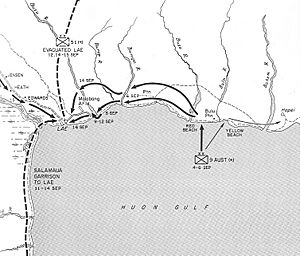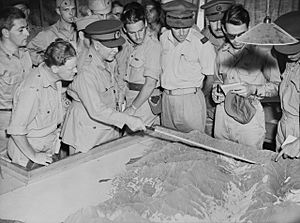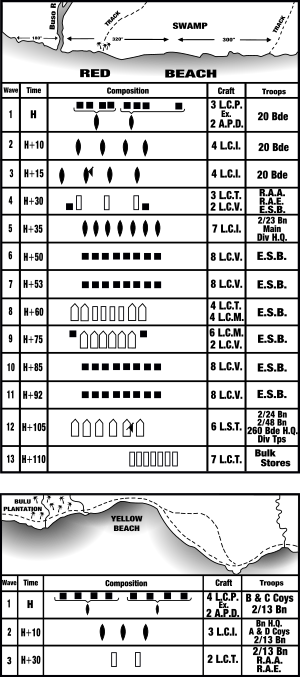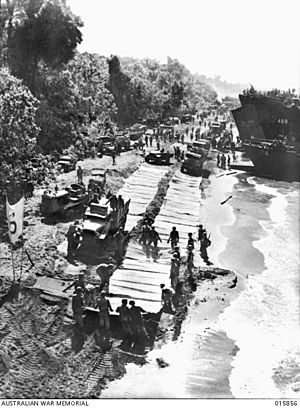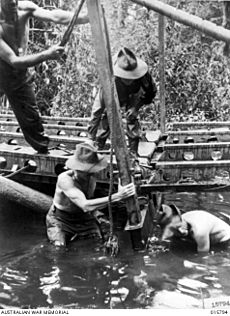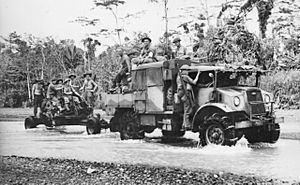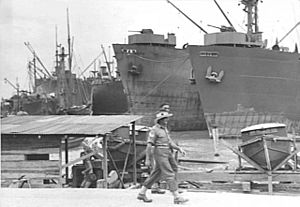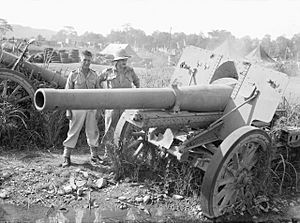Landing at Lae facts for kids
Quick facts for kids Landing at Lae |
|||||||
|---|---|---|---|---|---|---|---|
| Part of World War II, Pacific War | |||||||
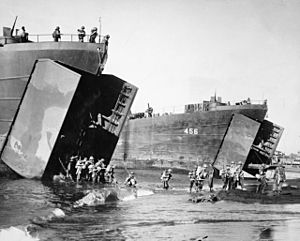 Australian troops disembarking from American Landing Ships, Tank (LST), including LST-456, at Red Beach |
|||||||
|
|||||||
| Belligerents | |||||||
| Commanders and leaders | |||||||
| Units involved | |||||||
|
I Corps
|
XVIII Army
|
||||||
The Landing at Lae was a major military operation during World War II. It involved Australian soldiers landing from ships onto beaches near the town of Lae in New Guinea. This happened between September 4 and 6, 1943. The goal was to capture Lae, which was an important Japanese base.
This landing was part of a bigger plan called Operation Postern. Australian troops from the 9th Division led the attack, with help from US Navy ships. It was the first big landing operation for the Australian Army since the Gallipoli Campaign in World War I. The Australians spent a lot of time planning it carefully.
First, one group of soldiers landed on two beaches about 27 kilometers (17 miles) east of Lae. Once they secured the beach area, more soldiers came ashore. Over the next few days, the rest of the division arrived. This landing worked together with another operation: an airborne landing by Australian troops at Nadzab. The 9th Division then advanced towards Lae from the beaches, while the 7th Division advanced from Nadzab.
The advance was tough because of bad weather, problems getting supplies, and strong resistance from Japanese defenders. Soldiers from the 7th Division reached Lae first on September 16. The 9th Division entered the town the next day.
Contents
Why the Allies Attacked Lae
In July 1942, the United States military leaders decided on a series of operations. These were led by General Douglas MacArthur, who was the top commander in the Southwest Pacific. Their main goal was to reduce the threat from the Japanese base at Rabaul. This base was blocking Allied ships and planes from moving between the United States and Australia.
After fighting off several Japanese attacks in 1942 and early 1943, the Allies started to take control. In March 1943, MacArthur's plans were reviewed. They couldn't get all the resources they wanted, so the plan to capture Rabaul was delayed. Instead, the new goals were:
- To take Kiriwina and Woodlark Islands and set up airfields there.
- To capture the Lae–Salamaua–Finschhafen–Madang area and build airfields.
- To take western New Britain and set up airfields at Cape Gloucester, Arawe, and Gasmata.
The second part of this plan, capturing the Lae area, was given to General Sir Thomas Blamey's New Guinea Force. This force was mostly made up of Australian soldiers. Because of this, the Australian Army carried out most of the military attacks in New Guinea in 1943.
Why Lae Was Important to Japan
In early 1942, Japan wanted to control the sea areas north and east of Australia. They saw the airfields around Lae and Salamaua as very important for this. Japanese naval troops captured Lae in February–March 1942. Lae then became a key base for Japanese aircraft.
By 1943, Japan had separate army and navy headquarters at Rabaul. These worked together but reported to different higher commanders. After a Japanese convoy carrying troops was destroyed in the Battle of the Bismarck Sea, Japan decided not to send more ships directly to Lae. Instead, they landed troops at Hansa Bay and Wewak. From there, soldiers would travel to Lae by barge or submarine. They also hoped to build a road over the Finisterre Range to Lae.
By June 1943, the Japanese had about 80,000 soldiers in New Guinea. Only one of their divisions, the 51st Division, was actively fighting the Allies near Salamaua. Like the Allies, the Japanese faced huge problems getting supplies and moving their troops into battle.
The Land Around Lae
Lae is located at the western base of the Huon Peninsula, on the southern side of the Huon Gulf. The land there was mostly flat and well-drained. Lae was a port for gold fields to the south, but it didn't have a proper harbor. The water offshore was deep, so there were only a few places for ships to anchor.
The beaches east of Lae were good for landing ships. They had firm black sand or small stones and were about 20 yards (18 meters) wide. However, there were few ways to get off the beaches. Most of the area behind them was dense jungle and mangrove swamps. There were no roads. Many streams and rivers cut through the area. The most important ones were the Burep and Busu Rivers. These rivers were not very wide or deep, but they flowed quickly. This made them difficult for soldiers to cross.
Planning the Landing
The landing was carried out by Major General George Wootten's 9th Division. These soldiers were experienced fighters from battles in North Africa, like the siege of Tobruk and the Battles of El Alamein. After returning to Australia, they trained for jungle warfare. They also practiced landing from ships at Trinity Beach in Cairns, Queensland, with the American 2nd Engineer Special Brigade. This American unit had many small landing craft.
At first, the plan was to move a small group of soldiers along the coast from a base at Morobe. But General Blamey thought this was too risky with Japanese air bases nearby. So, he got approval to use the entire 9th Division. They would be carried by larger landing ships from the US Navy's VII Amphibious Force. These ships could travel directly from Milne Bay to Lae. In July and August 1943, the 9th Division moved to Milne Bay.
This was the first major landing operation for Australian forces since Gallipoli. So, a lot of planning went into capturing Lae. Wootten chose landing sites far enough away from Japanese artillery in Lae. "Red Beach" was 27 kilometers (17 miles) east of Lae, and "Yellow Beach" was near Malahang. This was the first time in this area that beaches were given color names. Soldiers studied models of the beaches, but the names were kept secret. They also practiced the landing on Normanby Island.
Leaders from the Australian Army, US Navy, and air forces met to agree on plans. They discussed how to carry supplies. The 9th Division needed a lot of food and ammunition. They borrowed 200 trucks from the US Army to help unload supplies quickly.
Wootten wanted to land at night for surprise, but there would be no moon. So, the landing time was set for 6:30 AM, just after sunrise. Air support would not be available in the afternoon. This meant ships had to leave by 11:00 AM. This raised concerns about whether all supplies could be unloaded in just 4.5 hours.
A key part of the plan was to keep pressure on the Japanese around Salamaua to the south-west. This was meant to draw Japanese soldiers away from Lae. This tactic worked very well. The Japanese 51st Division sent thousands of troops to Salamaua throughout the campaign. Allied intelligence believed there were about 7,250 Japanese soldiers in Lae.
The Battle Begins
The Landing on the Beaches
The 20th Infantry Brigade left Milne Bay on September 2. The first groups of soldiers traveled in fast destroyer transports. Other soldiers came in larger landing craft. The US Fifth Air Force bombed Japanese bases at Madang and Wewak to support the operation.
The ships stopped at Buna on September 3. Later that day, Japanese bombers attacked landing craft at Morobe, but caused no damage. On the night of September 3/4, the final journey to the landing beaches began. US destroyers fired shells at the shore before the landing. The Japanese soldiers guarding the beaches left their posts instead of fighting.
However, there was resistance from the air. As the fifth group of landing craft approached Red Beach, Japanese planes attacked. One bomb hit the deck of USS LCI-339, causing severe damage and fire. Another ship, USS LCI-341, was also badly damaged. Eight Australians were killed, including a commanding officer, and 45 were wounded.
Despite the air attacks, the landing continued. Within four hours, about 8,000 soldiers were ashore. The 2/13th Infantry Battalion landed at Yellow Beach and secured the area. The 2/15th Infantry Battalion landed at Red Beach. The 2/17th Infantry Battalion landed behind them and pushed west across the Buso River. The 26th Infantry Brigade then followed, moving through the first groups and pushing further west.
Engineers quickly worked on the beaches. They laid wire mesh, cut down trees, built roads, and set up supply areas. While the large landing ships (LSTs) were unloaded quickly, some of the smaller ones (LCTs) took longer. This was because not enough soldiers were assigned to help unload them.
Later, around 1:00 PM, about 70 Japanese aircraft attacked six LSTs heading for Red Beach. US P-38 Lightning fighter planes helped defend the ships. USS LST-473 was hit by two bombs. Eight Americans were killed, and 37 Americans and Australians were wounded. USS LST-471 was hit by a torpedo. Forty-three Americans and Australians were killed, and 30 were wounded. The 2/4th Independent Company, a special forces unit, suffered heavy losses.
The remaining ships continued to Red Beach. On their way back, two other LSTs towed the damaged ships to Morobe. Japanese planes attacked the beach again at 3:30 PM. An ammunition dump exploded, and a fuel dump caught fire.
The next day, the 26th Brigade advanced about 6 kilometers (4 miles) from the landing site. The 24th Infantry Brigade, which was the division's reserve, came ashore on the evening of September 5/6. In the days that followed, the Australians advanced with two brigades leading the way. The 24th Brigade moved along the coast, and the 26th Brigade moved about 4 kilometers (2.5 miles) inland. The 20th Brigade stayed behind to guard the beachhead.
Pushing Towards Lae
After the landing east of Lae, the 7th Division flew into Nadzab. Their job was to advance from the north-west. They would also act as a shield against any Japanese reinforcements coming from the Markham and Ramu Valleys. The 9th Division's first advance along the coast met little resistance. Most Japanese groups were small.
However, the Japanese command ordered the 51st Division to reinforce Lae. This division was falling back from the Salamaua area. West of the Buso River, there were many small creeks and four major rivers. The 2/23rd Infantry Battalion, which had crossed the Buso on the first day, faced difficult river crossings and tough marches through the jungle.
The 2/23rd pushed across the Bunga and Buiem Rivers. On September 6, a Japanese company attacked the 2/23rd's main position. The Australians fought them off, but the Japanese mortars caused many casualties. The Japanese company then fell back towards an Australian platoon near the Bunga River. This platoon was attacked six times but managed to hold its ground.
The Japanese attack delayed the 9th Division's advance for several days. During this time, heavy rain started, flooding the many rivers and streams. This made them even harder to cross. Supplies were brought forward from Red Beach by landing craft. The advance was slow because the ground was muddy, and the thick jungle and tall grass forced the troops to cut new paths.
By September 8, the Japanese commander ordered his forces in Lae to start withdrawing north. It was clear that the Allied attacks from two directions would surround them. On the same day, the Australians faced their biggest challenge: the Busu River. It was 700 meters (2,300 feet) wide and 1.8 meters (6 feet) deep. Three days of heavy rain had flooded the river, making it very dangerous.
The Australians had to cross without special bridging equipment or boats. The 2/28th Infantry Battalion tried to get a cable across the river, but it failed. They then focused on the river mouth, where a small island offered some cover. Under heavy fire from Japanese mortars and machine guns, the Australians charged across the river. Thirteen Australians drowned, and many more were swept away. Despite this, the 2/28th made it across and secured a foothold on the other side.
The bad weather continued to slow the 9th Division. The 26th Brigade, further inland, was stuck on the eastern side of the Busu. Engineers worked to build a jeep track and bring up boats and cables. They tried several times to cross the river, but Japanese fire stopped them. Heavy fighting took place in the swamp around the crossing.
On September 13, more engineering supplies arrived, including bridging equipment. The next day, a special bridge was built across the Busu, allowing the 26th Brigade to finally cross on September 14.
The 26th Infantry Brigade immediately fought the Japanese on the other side. They pushed towards Kamkamun and the Malahang Mission. Meanwhile, the 24th Infantry Brigade advanced along the coast. The weather and problems with supplies made the 9th Division's progress difficult. As a result, the 7th Division's troops reached Lae first. They entered the town on the morning of September 16, just ahead of the 24th Infantry Brigade, which had captured the Malahang airfield the day before.
Building Up Lae After the Battle
After Lae was captured, Brigadier David Whitehead was in charge of the town. Under his direction, garbage was burned, Japanese bodies were cremated, and bomb craters were filled in. American and Australian units sprayed for mosquitoes to prevent malaria.
Lae was not meant to be a major air base. However, the 9th Division wanted to use the Lae Drome for evacuating wounded soldiers and for planes to spot artillery fire. By September 18, the airfield was extended, allowing four Australian planes to land. Later, a road to other airbases was closed due to heavy rain. This meant fuel had to be shipped to Lae and then flown to the other airbases. At one point, a plane took off or landed at Lae Drome every 26 seconds.
Developing Lae as a port was planned from the start. But when the town was captured, the port was blocked by sunken barges and debris. The only places to unload ships were two weak jetties. At first, cargo was brought ashore over the beach using special amphibious vehicles. The US Navy only allowed large landing ships to arrive at night. Only in November did they allow them to operate in daylight.
Sunken Japanese barges were removed by a large floating crane. American engineers then built a floating dock. It opened on October 20. A new dock was finished on November 23. A fuel jetty was also built, and a pipeline was laid to Nadzab.
What Happened Next
After Lae was captured, the Japanese military leaders decided to pull back to a new defense line. About 9,000 Japanese soldiers began withdrawing across the Busu River and then through the Saruwaged and Finisterre Ranges. They moved towards the north-east coast. At the same time, efforts were made to strengthen the Huon Peninsula.
The Allies found a copy of the Japanese withdrawal order. They tried to cut off the retreating troops. There were heavy clashes along the Markham Valley Road. Many Japanese soldiers ran out of food and left behind important equipment. They reached their new positions in mid-October, having lost another 600 to 1,000 men during the march. The 9th Division lost 77 soldiers killed, 397 wounded, and 73 missing.
The Allies then launched a new campaign on the Huon Peninsula. The 20th Infantry Brigade landed at Scarlet Beach. At the same time, the 22nd Infantry Battalion, an Australian unit, marched from Hopoi Mission Station to Finschhafen. This was a very difficult march of 50 miles (80 kilometers) over rough land in 10 days.
The 7th Division later advanced towards Dumpu through the Markham and Ramu Valleys. They also crossed the Finisterre Range on their way to Madang during the Finisterre Range campaign. These advances gave the Allies access to important airfields. From these airfields, they could launch air attacks and control more of the area.


